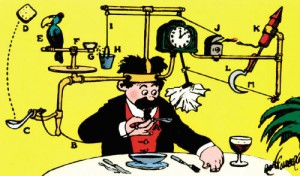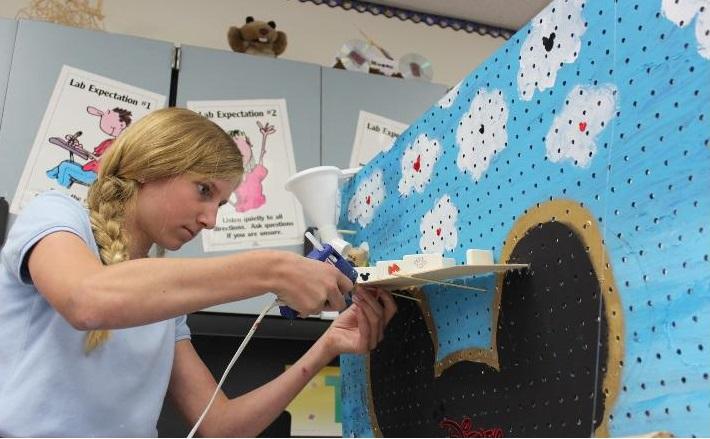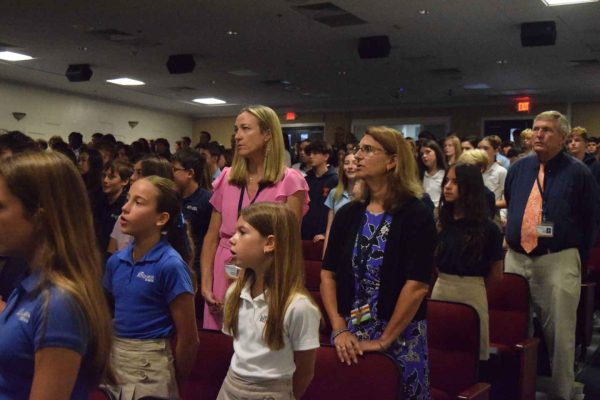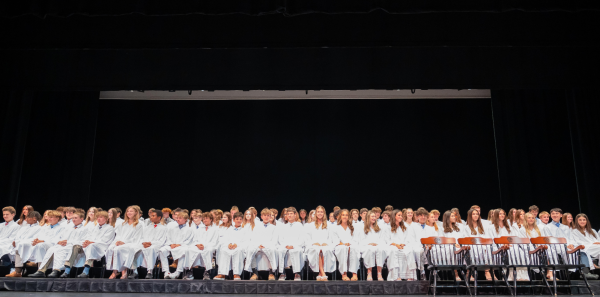Engineering Cool Contraptions
For their final project, the eighth-grade advanced science students are creating their own Rube Goldberg devices.
Eighth grader Regan Kretz uses a glue gun to affix some components to her Disney-themed Rube Goldberg project.
Too lazy to get a glass of water? The eighth grade SEAT (Science Engineering Analysis and Technology) classes are creating Rube Goldberg machines that could easily help with this predicament.

This Rube Goldberg cartoon illustrates the self-operating napkin, one of his many sketches detailing a convoluted mechanism created to perform a simple task.
Rube Goldberg himself created the first Rube Goldberg machines, not with wires and marbles, but instead with pen and paper. The early 20th-century cartoonist and inventor drew many cartoons of these machines, one of the most famous ones being the self-operated napkins.
Despite the elaborate and entertaining nature of such devices, Benjamin’s middle school students believe they are receiving valuable engineering know-how via their Rube Goldberg machines. “The project really shows us the engineering process, how simple machines work, and how Rube Goldberg machines work,” said eighth grader Regan Kretz, a member of one of the SEAT classes.
This belief corresponds with the purpose behind building the machines, which is done under the direction of Ms. Gabriele St. Martin, the middle school science department chair and teacher of the SEAT classes. According to her, “it is an engineering project in which students use the engineering design process to design and test their Rube Goldberg projects. They learn how simple machines work by using them, rather than the more formal classroom method of lecturing about them.”
St. Martin came up with the initial idea of Rube Goldberg machines at the annual FCIS (Florida Council of Independent Schools) Conference a few years ago. She attended a science session and a school demonstrated how it built a Rube Goldberg as a part of its physics unit on simple machines. So, she chose to recreate the project for the eighth graders which will not only help them as they move forward with Benjamin’s STEM curriculum, but with their other academic courses as well.
“The Rube Goldberg project corresponds indirectly through the problem-solving and perseverance that students learn during that activity to all high school classes, not just engineering,” explained upper school science teacher Mr. Darryl Martino.
The project’s objective is for a student or a pair of students to create a Rube Goldberg machine which allows a standard-sized marble to run through

the course for at least 45 seconds using both sides of a two-foot by three-foot pegboard. The students are given a pegboard or they can buy their own (as long as they match the same measurements as the school-provided ones). The students must decorate and build on both sides of their pegboards with more common objects such as paper towel rolls or PVC pipe. The students must also use at least four different types of simple machines and include seven in total, which can range from wedges, axles, and levers to pulleys, screws, and wheel-and-axle combinations. There has to be an objective or action met at the end of the machine, like raising a flag or opening a treasure chest. The project also provides extra credit to students. They can receive an extra five points if their marbles run between 42 and 48 seconds. Also for every five additional simple machines, such as an incline plane or pully, an extra point will be awarded.
In addition, the students have to create their own theme for their projects, which range from fire and ice to a zoo to the New York Giants. Many of the students come up with their Rube Goldberg themes by discussing common interests and ideas with their partners. “My partner and I have a common interest in the sport of basketball, so we decided it would be most fun and engaging for the both of us to do a topic we are familiar with and will be able to have input into,” said eighth-grade SEAT student Christian Baldari.
The creative process is one of the simpler parts of the experiment while the time and space limit seems to be one of the most challenging aspects of the project. “The Rube Goldberg machine projects are tough yet fun,” said eighth grader Joey Berg. “It’s interesting and challenging to make all the pieces of our Rube Goldberg fit and work against the time limit [of 45 seconds], but it’s a lot of fun to see it all work in the end.”





